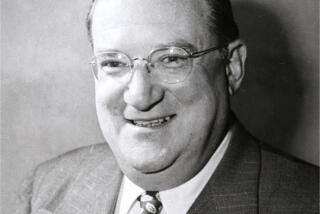Building a Shrine for Williams, Splinter by Splendid Splinter
- Share via
HERNANDO, Fla. — Ted Williams didn’t realize that opening up to the public could be so much fun.
It has provided a lesson in the value of friendship and allowed some of the people closest to him to demonstrate how much they care about the 75-year-old Hall of Famer, who cherishes his privacy as much as anyone.
When the doors to the Ted Williams Retrospective Museum and Library later this month in this tiny community in north-central Florida, the last man to bat .400 for an entire season will welcome the spotlight he usually shuns.
“I don’t pray much, but I’m thankful I’m still breathing every morning. I feel it’s a hell of an asset and I’ll take that for the day,” said Williams, who suffered a stroke in 1991 and has, in recent months, been coping with the death of a longtime female companion.
“All of this has emphasized to me how important friends are, how lucky I am to have so damn many of them,” he added, gesturing to some of the soon-to-be filled display cases in the 5,200-foot building that will house memorabilia, photographs and other items paying tribute to his life in and out of baseball.
“This makes you realize some things as you go along, that you’re pretty fortunate and pretty lucky.”
Most of the exhibits for the museum, which opened last week, were donated by ex-major leaguers and other friends of the six-time American League batting champion.
Hurricane Donna destroyed Williams’ home in the Florida Keys in 1960--the year he retired from the Boston Red Sox--and many of the items he collected from a career that spanned 19 seasons were lost in the storm.
One wing of the museum is dedicated to his military service. Another recognizes his achievements as an outdoorsman, including life-sized replicas of the some of the prize catches from fishing expeditions to places like New Zealand and Peru.
Although Williams originally rejected the idea of building a museum in his honor, he later consented to be a part of it on one condition: that friends organizing the project didn’t bother him with every detail.
“I wasn’t very enthusiastic about it at all, but I kept hearing about it and there was a lot of enthusiasm to do it,” Williams said.
“Finally, my consent was like this: ‘OK. If you want to do it, do it. But, don’t bother me with it.’ That’s been my feeling because I don’t want to be worried about every picture or every bat or anything that’s going to be put in here.”
Plans call for the museum to become more than just a tribute to Williams. Organizers say a Hitters’ Hall of Fame will be added next year and could eventually include an 80-seat theater where visitors will be able to watch movies and other video presentations.
Williams already has selected the initial class of 20 inductees for the Hitters’ Hall of Fame. And, the museum plans to add new members--and possibly stir debate among baseball enthusiasts--each year after 1995.
“For anybody to come out and say, ‘Here are the 20 greatest hitters,’--that’s a hard assignment, even for somebody who’s played it, lived it, breathed it and was born into it,” Williams said.
“But we’ve researched the whole thing. We have narrowed it down to where we feel we have 20 hitters that we can live with, and we can argue every way logically why this guy maybe was a shade better than that guy.”
An intensely private person, Williams rarely makes public appearances. He spends about six months of the year living in Citrus County, near the museum, and also has a summer lodge near New Brunswick, Canada, where he likes to fish on the Miramichi River.
Because he doesn’t like the crowds he attracts and tries his best to avoid the spotlight when he ventures away from home, close friend Lewis Watkins believes Williams is probably misunderstood by most people.
“I’ve heard horror stories and had people tell me stories. But I’ll tell you, there’s not a bad bone in his body,” said Watkins, director of the museum.
“He’s an introvert. Ted basically does not like new people, does not like to have people up on him. He’s withdrawn, but every time somebody becomes a good friend or he thinks they’re becoming a good friend, they want something.”
The museum, Watkins said, is a way for Williams to open up without totally giving up his privacy.
“I don’t know that there could be many museums built for other Hall of Famers. You’ve got to have the following,” Watkins said.


